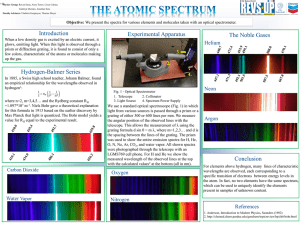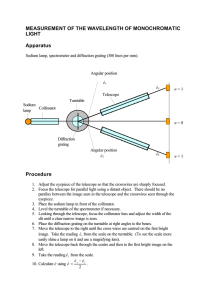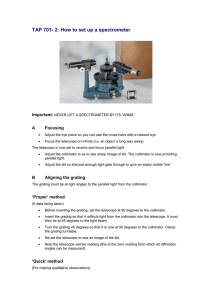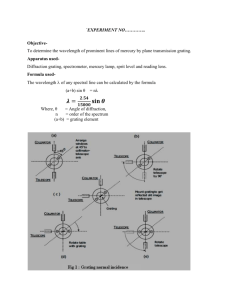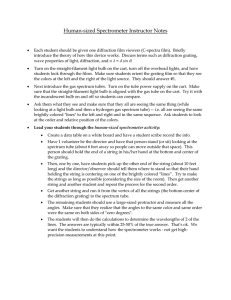Atomic Spectra
advertisement
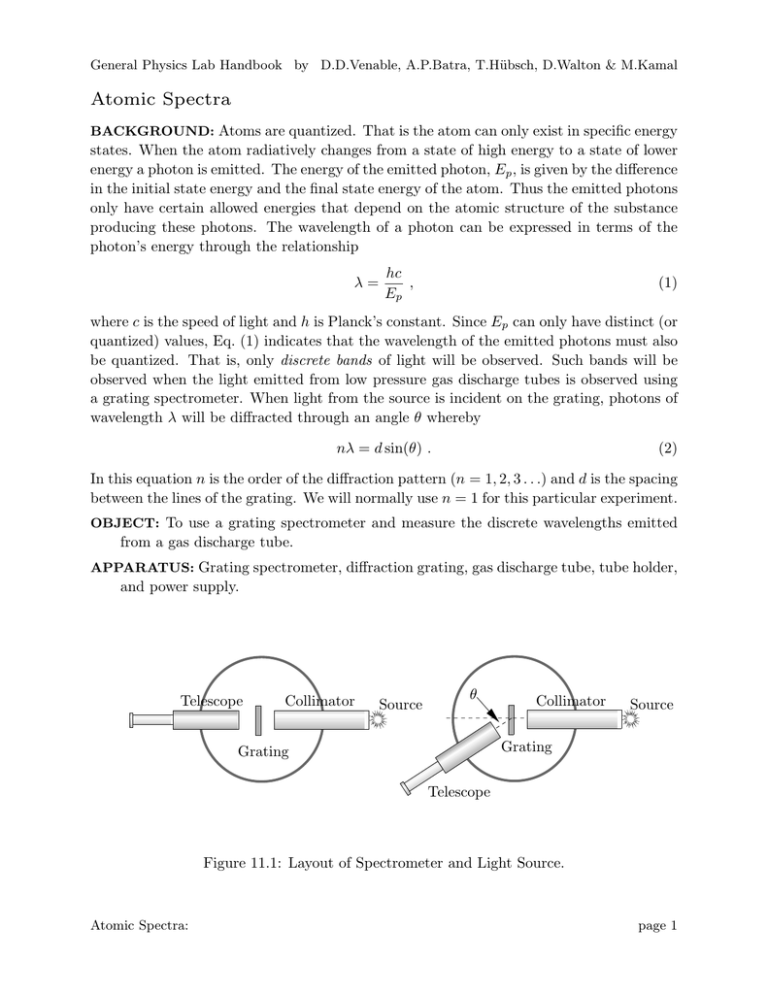
General Physics Lab Handbook by D.D.Venable, A.P.Batra, T.Hübsch, D.Walton & M.Kamal Atomic Spectra BACKGROUND: Atoms are quantized. That is the atom can only exist in specific energy states. When the atom radiatively changes from a state of high energy to a state of lower energy a photon is emitted. The energy of the emitted photon, Ep , is given by the difference in the initial state energy and the final state energy of the atom. Thus the emitted photons only have certain allowed energies that depend on the atomic structure of the substance producing these photons. The wavelength of a photon can be expressed in terms of the photon’s energy through the relationship λ= hc , Ep (1) where c is the speed of light and h is Planck’s constant. Since Ep can only have distinct (or quantized) values, Eq. (1) indicates that the wavelength of the emitted photons must also be quantized. That is, only discrete bands of light will be observed. Such bands will be observed when the light emitted from low pressure gas discharge tubes is observed using a grating spectrometer. When light from the source is incident on the grating, photons of wavelength λ will be diffracted through an angle θ whereby nλ = d sin(θ) . (2) In this equation n is the order of the diffraction pattern (n = 1, 2, 3 . . .) and d is the spacing between the lines of the grating. We will normally use n = 1 for this particular experiment. OBJECT: To use a grating spectrometer and measure the discrete wavelengths emitted from a gas discharge tube. APPARATUS: Grating spectrometer, diffraction grating, gas discharge tube, tube holder, and power supply. Telescope Collimator Source θ Collimator Source Grating Grating Telescope Figure 11.1: Layout of Spectrometer and Light Source. Atomic Spectra: page 1 General Physics Lab Handbook by D.D.Venable, A.P.Batra, T.Hübsch, D.Walton & M.Kamal PROCEDURE: 1. The gas discharge tubes are connected to a high voltage power source. Additionally the tube becomes very hot when in use. Exercise CAUTION when using this apparatus. Connect the spectra tube to the power source as instructed by the laboratory instructor. 2. Arrange the spectrometer so that its collimator arm is adjacent to the gas discharge tube. Looking through the collimator you should see a small rectangle of light coming from the discharge tube. The rectangle is formed by the small slit on the end of the collimator. 3. Arrange the telescope arm of the spectrometer so that it is aligned with the collimator. Place the grating on the spectrometer and carefully arrange it so that it is perpendicular to the collimator. With this alignment, the light will be incident normal to the grating. 4. Looking through the telescope arm you should again see the slit. Focus the eye piece until a sharp image is obtained. If necessary, rotate the eyepiece slightly so that the slit is in the center of the field of view. 5. Adjust the scale on the spectrometer, without moving the telescope and collimator, so that the scale reads 0◦ . If it is not possible for you to make this adjustment, then you will need to record this reading and make all subsequent measurements relative to this value. 6. Swing the telescope slowly away (clockwise) from 0◦ until a series of bright lines is observed. Record the angle θ that corresponds to the angular location of the observed lines for the colors indicated in the data table. If more than one line is observed for a given color, use the angular location for the first observed lined, i.e. the line that corresponds to the smallest angular displacement. Record the angular locations in the tables. (Be certain to correct the measurements for any zero off-set that you noted in step 5 above.) 7. Repeat the same series of measurements by swinging the telescope counter-clockwise from the zero position. 8. Complete the data table and compare the calculated value of λ with the known values provided by the laboratory instructor. QUESTIONS: 1. Why is it correct to use n = 1 when calculating λ from Eq. (1) in this experiment? 2. If one wanted to determine the relative amount of the substance in the discharge tube, what other information (other than λ) could you observe in this experiment to assist in making this determination? Atomic Spectra: page 2 General Physics Lab Handbook by D.D.Venable, A.P.Batra, T.Hübsch, D.Walton & M.Kamal Measurements and Calculated Values for First Material Material = Grating Spacing (d)= Angle (degrees) Color Clockwise Rotation CounterClockwise Rotation Calculated λ Correct λ % error Average Value Violet Blue Green Yellow Orange Red Atomic Spectra: page 3
